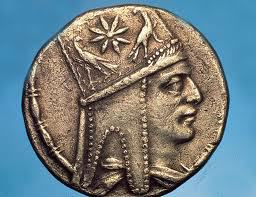There is a schism amongst the Shembe Nazarites as to whether or not Shembe included Jesus in his new cosmology. I am in a postiion to settle this argument by making these Nazarites aware of Queen Helena of Abiabene the Nazarite, whose sons fought the Slave Owners of Rome for the Temple as Jerusalem. It is alleged Helena’s people were Kurds, who are fighting the ISIS slave owners who have marked the “Nazarites” for death. What I am seeing is the prophecy among the Magi, that foretold the birth of a Jewish Messiah -that was seen by the forerunner John the Baptist ‘The Nazarite For Life and the Second Coming of Elijah’ – is relavent to a continuing prediction involving Nazarites and the Parthian-Kurds.
The Jewish Roots of Kurdistan
The history of Judaism in Kurdistan is ancient. The Talmud holds that Jewish deportees were settled in Kurdistan 2800 years ago by the Assyrian king Shalmaneser. As indicated in the Talmud, the Jews were given permission by the rabbinic authorities to allow conversion from the local population. They were exceptionally successful in their endeavor. The illustrious Kurdish royal house of Adiabene, with Arbil as its capital, was converted to Judaism in the course of the 1st century BCE, along with, it appears, a large number of Kurdish citizens in the kingdom (see Irbil/Arbil inEncyclopaedia Judaica).
The name of the Kurdish king Monobazes (related etymologically to the name of the ancient Mannaeans), his queen Helena, and his son and successor Izates (derived from yazata, “angel”), are preserved as the first proselytes of this royal house (Ginzberg 1968, VI.412). [But this is chronologically untenable as Monobazes’ effective rule began only in CE 18. In fact during the Roman conquest of Judea and Samaria (68-67 BCE), Kurdish Adiabene was the only country outside Israel that sent provisions and troops to the rescue of the besieged Galilee (Grayzel 1968, 163) – an inexplicable act if Adiabene was not already Jewish].
Many modern Jewish historians like Kahle (1959), who believes Adiabene was Jewish by the middle of the 1st century BCE, and Neusner (1986), who goes for the middle of the 1st century CE, have tried unsuccessfully to reconcile this chronological discrepancy.
All agree that by the beginning of the 2nd century CE, at any rate, Judaism was firmly established in central Kurdistan.
Like many other Jewish communities, Christianity found Adiabene a fertile ground for conversion in the course of 4th and 5th centuries. Despite this, Jews remained a populous group in Kurdistan until the middle of the present century and the creation of the state of Israel. At home and in the synagogues, Kurdish Jews speak a form of ancient Aramaic called Suriyani(i.e., “Assyrian”), and in commerce and the larger society they speak Kurdish. Many aspects of Kurdish and Jewish life and culture have become so intertwined that some of the most popular folk stories accounting for Kurdish ethnic origins connect them with the Jews.
The tombs of Biblical prophets like Nahum in Alikush, Jonah in Nabi Yunis (ancient Nineveh), Daniel in Kirkuk, Habakkuk in Tuisirkan, and Queen Esther and Mordechai in Hamadân, and several caves reportedly visited by Elijah are among the most important Jewish shrines in Kurdistan and are venerated by all Jews today.
“A recent ABC News article May 19, 2004 noted that according to the Armenian and Italian researchers the “Symbol on his crown that features a star with a curved tail may represent the passage of Halley’s comet in 87 BC. Tigranes’ could have seen Halley’s comet when it passed closest to the Sun on Aug. 6 in 87 BC according to the researchers, who said the comet would have been a ‘most recordable event’ — heralding the New Era of the brilliant King of Kings.com·et
(kŏm’ĭt) n. “
A large Kurdish Peshmerga force is heading towards towns held by ISIS. Some of the ancestors of these warriors fought Rome for the Temple in 67 A.D.
“one who confronts death”
https://rosamondpress.com/2014/08/13/the-star-prophecy-2/
http://astrogeo.oxfordjournals.org/content/45/4/4.6.short
https://en.wikipedia.org/wiki/Halley%27s_Comet
Years ago I suggested Nazarite Queen Helena of Abiabene was the Sleeping Beauty Princess, Rosamond. I have found the remnant of the Nazarite church she founded in Iraq. The…
View original post 1,713 more words



